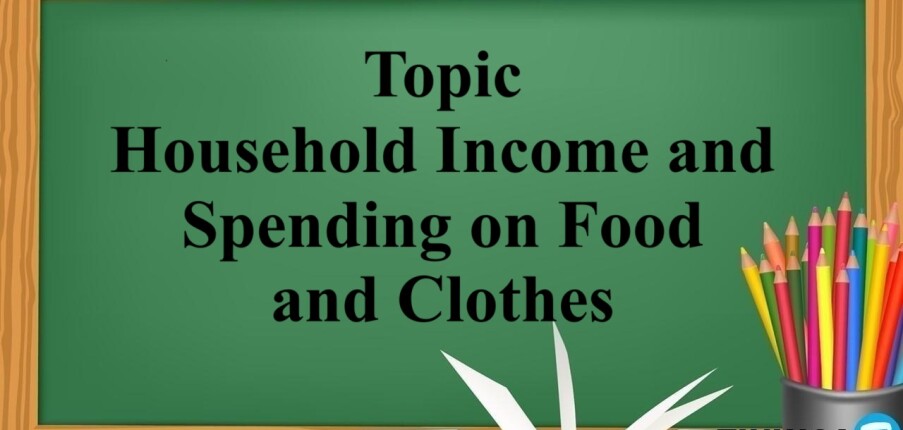Topic : Household Income and Spending on Food and Clothes | Bài mẫu IELTS Writing Task 1
Đề bài
The pictures show information about average income and spending on food and clothes by an average family in a city in the UK.
Dàn ý
1900 sẽ miêu tả biểu đồ với 1 câu mở bài (Intro), đoạn miêu tả tổng quát (Overview), và 2 đoạn thân bài miêu tả chi tiết (Detailed Description)
- Mở bài: 1900 sẽ paraphrase lại đề bài để giới thiệu lại đề bài cho người chấm
- Miêu tả tổng quát: 1900 miêu tả các chi tiết quan trọng, nổi bật nhất trong biểu đồ
- Thân bài: Vì đây là dạng Mixed nên ta sẽ dùng mỗi đoạn thân bài để miêu tả một biểu đồ
- Body 1: Mô tả biểu đồ bảng
- Body 2: Mô tả biểu đồ tròn
Vocabulary
Showcase
/ˈʃoʊˌkeɪs/
(verb). Cho thấy
The program showcases up-and-coming musicians.
Average household income
/ˈævərɪʤ ˈhaʊsˌhoʊld ˈɪnˌkʌm/
(noun). Thu nhập trung bình hộ gia đình
Average household income in the town hovers at $4000 monthly.
Percentage of expenditure
/pərˈsɛntəʤ ʌv ɪkˈspɛndəʧər/
(noun). Tỷ lệ chi tiêu
Expenditure on food, however, recorded a precipitous decline.
Witness a substantial decrease
/ˈwɪtnəs ə səbˈstænʧəl ˈdiˌkris/
(verb). Giảm đáng kể
The number of students taking this course witnessed a substantial decrease.
Increase slightly
/ˈɪnˌkris ˈslaɪtli/
(verb). Tăng nhẹ
Sales of the new product have increased slightly.
The majority of the sum
/ðə məˈʤɔrəti ʌv ðə sʌm/
(noun). Phần lớn của tổng số tiền
Spending on food and clothes increased slightly, with the majority of the sum being spent on Meat and Fish & Fruit and Vegetables.
Go down by 4000
/goʊ daʊn baɪ 4000/
(verb). Giảm 4000
The figure went down by 2000 just in 2 years.
Spending on food and clothes
/ˈspɛndɪŋ ɑn fud ænd kloʊðz/
(noun). Khoản chi cho thức ăn và quần áo
Spending on food and clothes made up a large proportion.
Percentage breakdown
/pərˈsɛntəʤ ˈbreɪkˌdaʊn/
(noun). Tỷ lệ phần trăm chia nhỏ
This query displays the percentage breakdown of employees
Constitute the largest percentage
/ˈkɑnstəˌtut ðə ˈlɑrʤəst pərˈsɛntəʤ/
(verb). Là tỷ lệ phần trăm lớn nhất
Information about a deceased person does not constitute personal data.
At a combined 54%
/æt ə kəmˈbaɪnd 54%/
(adv). Tổng cộng 54%
Within food spending, meat and vegetables constitute the largest percentage at a combined 54%.
Respectively
/rɪˈspɛktɪvli/
(adv). Lần lượt
I bought the jacket and the T-shirt for $40 and $25, respectively.
Bài mẫu IELTS Writing Task 1
Bài mẫu
The table chart showcases data surrounding the average household income in the UK, and the pie chart shows the percentage of expenditure spent on food and clothes by the average family.
Overall, although average income witnessed a substantial decrease, spending on food and clothes, on the contrary, increased slightly, with the majority of the sum being spent on Meat and Fish & Fruit and Vegetables.
Between 2010 and 2013, we can generally see that while average household income actually went down by 4000, from 29000 to 25000, spending on food and clothes actually increased from 14000 to 15000.
As for the percentage breakdown of the types of food and clothes the average family spends on, 75 percent of the total in 2010 was spent on foods, while 15 percent was spent on clothes. Within food spending, meat and vegetables constitute the largest percentage at a combined 54%, while dairy and other food products consisted of 12% and 18% of the total food expenditure respectively.
Bài mẫu band 6.5+
The table gives a brief account of average British household salary and spending a range of items, and the pie chart elaborates on the monetory allocation to each of the products in 2010 and 2013.
As can be seen, despite a descending resultant trend for the salary, a family's spending on food and clothes had slightly increased by 2013. Most notably, the ratio of fruits and vegetables surged in 2013.
Throughout 2010-13, the total income of a British family witnessed a decrease 4000£, reaching a low of 25000£. In contrast, their expenditure on food and clothes showed a hike of £1000 from £14000 to £15000 in 2013.
On analyzing the spending on food and clothes, by the beginning of the concerned period, a rather great share of expenses belonged to buying fruits and vegetables, and meat and fish. However, the proportion of both declined by 10% which reached 12% and 15% respectively in 2013. On the contrary, by 2013 expenditure on fruits and vegetables was reported to be slighly over one-third of the espenses due to a 15% rise in its consumption. Taking dairy products in consideration, there was a 5% upsurge in the expenses in comparison to 15% in 2010. In contrast, the figure for other food and drinks remained stable at 18% throughout the given period.
Bài mẫu band 7.0+
The table illustrates how much money an average family in a UK city earned and paid for food and clothes, while the pie charts compare the proportion of those categories in the years 2010 and 2013.
Looking from an overall perspective, it is readily apparent that although the total income of a British family decreased between 2010 and 2013, the amount of money spent on foodstuff and clothing saw an opposite trend. It can also be seen that British people have more consumption of food than clothes category in both years.
A deep analysis of the table provided reveals that in the year 2010, an average family earned 29000 dollars, which was more than twofold than spending on food. Moreover, three years later, there was a gradual dip in terms of a British household's earnings, from 29000 to 25000 dollars. By contrast, the expenditure on food and clothes saw a slight growth with the figure reaching 15000 dollars during the given period.
Regarding the pie charts, the percentage of spending on meat and fish was the highest of all categories in 2010 but witnessed a drop in 2013, from 29% to 23% respectively. It is also notable that the second most popular category in 2010 went into fruit and vegetables with 26%, climbing to the 1st rank in the next three years and reaching its peak at 30%. Dairy products also experienced an upward trend with the figure growing by 4% over a period of 3 years. In contrast, between 2010 and 2013, there was a fall in the proportion of clothes spending, at 15% and 13% respectively. However, the percentage of other food in a UK family remained steady during the period, at exactly 18%.
Submitted by yeshomeclass on Wed Mar 29 2023
Unauthorized use and/or duplication of this material without express and written permission from this site’s author and/or owner is strictly prohibited. Excerpts and links may be used, provided that full and clear credit is given to Writing9 with appropriate and specific direction to the original content.
Bài mẫu band 7.5+
The bar charts and table compare data about how much money people who lived in a city in the UK earned and invested in a range of items at 2 various times( 2010, 2013).
Overall, it was important that the number of costs that people spent climbed while their incomes were reduced; moreover, in both years people bought food that had vitamins a lot.
According to the table, at the beginning, populations who lived in a region of Bitainnia earned 29,000, but this amount of 4,000 declined the second time. In contrast, in 2013, communities spent 1,000 more than in the prior, which was 14,000.
The graphs demonstrate that the proportion of things that people spent money on not only meat and fish but also fruits and vegetables , the main section of people's meals, were 29 and 26 per cent; then the others fell a tiny fraction; however, the second one improved slightly to reached 30%. The third sector which had the same percentage as two years at 18% was Other foods. Later Dairy products and Clothes roughly had the same figure; furthermore, in 2013, Dairy products 4% rose to touched 16%; nevertheless, another 2% went down to hit 13%.
Bài mẫu band 8.0+
The picture above provides key information about how the average United Kingdom family spend their money on food and clothes. Also, the pie chart shows the percentage of spending on food and clothes between the years 2010 and 2013.
Overall, it is clear to the naked eye that nearly half of the total income of the UK family in both years was spent on clothes and food. Nevertheless, On the other hand, the pie chart shows that a third of the money went to fruits and vegetables in 2013.
However, in 2010, that number went to meat and fish, with a small percentage of spending on clothes as a result. In terms of dairy products. In addition, it has never changed so much since the next few years, which increased from 12 present in 2010 to more than 15 present in 2013, and when it comes to other food, it is obvious that it did not change at all in three years.
Xem thêm các tài liệu Tiếng Anh hay, chi tiết khác:
TOP Việc làm "HOT" dành cho sinh viên:



